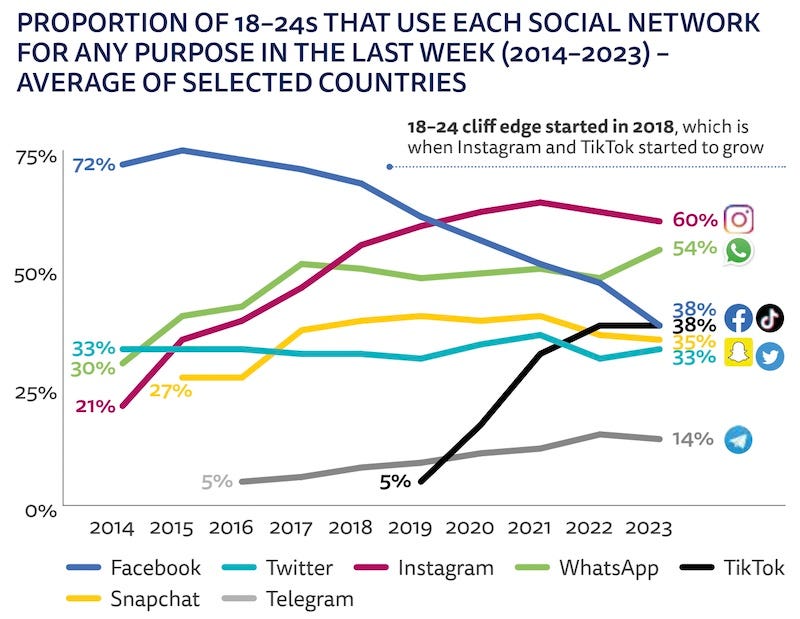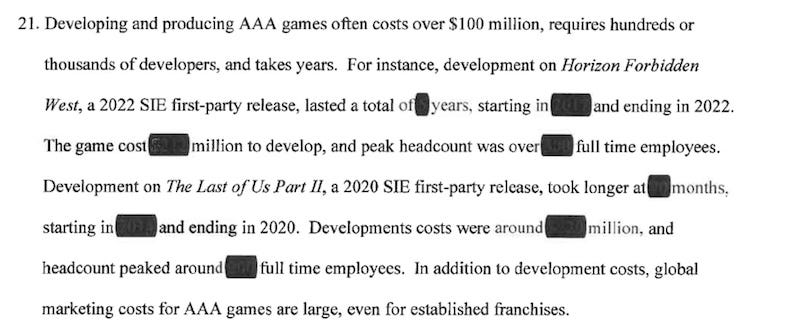PlayStation's top first-party games now cost >$200 million to make
Also: more some choice Call Of Duty stats, and lots of platform news
[The GameDiscoverCo game discovery newsletter is written by ‘how people find your game’ expert & company founder Simon Carless, and is a regular look at how people discover and buy video games in the 2020s.]
Time for mid-week madness. And actually, it truly is madness this time, with our original lead and ‘B’ story getting pre-empted by new - surprisingly sourced - data from the FTC x Microsoft trial, on both Sony’s games and Call Of Duty.
Oh, and it’s the final 48 hours to get that 25% off deal for our GameDiscoverCo Plus paid sub, including Discord access, our Steam ‘Hype’ & post-release back-end, multiple eBooks, exclusive newsletter & more. If you dig us, you know what to do…
Sony’s biggest franchise dev costs? >$200m
Like many data nerds, we’ve been going through the files presented as evidence in the ‘FTC vs. Microsoft’ lawsuit over their wished-for acquisition of Activision Blizzard.
Unfortunately, a lot of the more interesting data is censored. But there’s one weird exception. SIE head Jim Ryan’s 18 page declaration, as pointed out by a friend of GameDiscoverCo and also spotted by The Verge, has been, uh, incompetently redacted.
This leads to passages like the following, where - unbelievably - the data isn’t fully removed, so you can still see the underlying numbers if you squint:
We’re not going to attempt to decode all of the fully redacted paragraphs. But it does give us clear insight into a few specific numbers, as follows:
Sony’s top first-party titles now have dev costs exceeding $200 million: According to the document: “Development on [Guerrilla’s] Horizon Forbidden West, a 2022 SIE first-party release, lasted a total of 5 years, starting in 2017 and ending in 2022. The game cost $212 million to develop, and peak headcount was over 300 people.” We estimate this game has close to 9 million players on PlayStation, though 2-3 million of those may be PS+ Game Catalog subscribers.
Naughty Dog’s The Last Of Us Part II took even longer to create: “Development on The Last Of Us Part II, a 2020 SIE first-party release, took longer at 70 months, starting in 2014 and ending in 2020. Development costs were around $220 million, and headcount peaked around 200 full time employees.” GameDiscoverCo reckons around 15 million owners of the game, & even with a $40 USD cost (and a PC version to come?), it’s clearly still profitable.
So these signature titles seem to be profit-generating for Sony - though we can’t see marketing costs, which were hefty - especially because on PlayStation, Sony can pay themselves their 30% platform fee!
But games like Forbidden West don’t have a lot of ongoing direct revenue, especially now they’re in Game Catalog, showing why Sony is getting aggressive with ‘live game’ GaaS titles. (Mind you, these first-party ‘prestige’ games are also selling PlayStation hardware - if available on those platforms first - of course.)
Call Of Duty’s topline PlayStation numbers - wow!
The other clearly visible ‘not correctly redacted’ data in Ryan’s testimony is around Activision’s Call Of Duty franchise itself. Nothing in here is surprising. But the numbers are nonetheless eye-opening, and certainly help explain Sony’s deal unease:
Call Of Duty is a >$1 billion yearly franchise solely on PlayStation: According to data from PlayStation’s Ryan, the Call Of Duty franchise generated over $800 million in U.S. spending on Sony hardware (including IAP) in 2021, and $1.5 billion in worldwide spending. And the franchise as a whole (multi-platform) has lifetime earnings of $27 billion as of 2020, according to Activision.
CoD’s penetration on PlayStation devices in the U.S. is super-high: Call Of Duty has been played by “more than 43 million unique PlayStation users”, two thirds of PlayStation’s 64 million user U.S. account base, since 2019. That’s a very big percentage. (Oh, and they used 32 million PlayStation devices to do it, giving us an interesting snapshot of ‘# of PS accounts per device’ for this game - 1.35x.)
Modern Warfare II has the record for the highest-selling Week 1 PlayStation game: Ryan says that Call of Duty: Modern Warfare II sold 4.4 million units on PlayStation worldwide during its first week of sale in October 2022, “easily vaulting the previous record of 3.8 million units” held by FIFA 23.
What does this all say? That - especially after the ‘return to form’ for Call Of Duty in 2022 with Modern Warfare II, after CoD: Vanguard disappointed in 2021 - Sony has a lot at stake if Call Of Duty comes to be owned by a major console rival.
And as we established on Monday, there’s no love lost between Sony and Microsoft, with Phil Spencer saying that Sony uses its heft and the money earned by Microsoft-owned games on its platform to “do things to try to reduce Xbox’s survival on the market”.
So if Microsoft does come to own Call Of Duty via the Activision deal, these numbers underscore how awkward it’s going to be for both parties. It’s 100% doable, with the correct ‘walls’ in place. But it’s going to be a super messy situation if the deal closes, especially after this Sony-supported government pushback.
The game discovery news round-up..

So let’s finish things out with interesting game platform and discovery news, sourced from the heaps of data and insight careening around the Internet right now:
Sentiment on game sub services from the FTC trial? This quote from PlayStation’s Jim Ryan yesterday stuck with us: “I talked to all publishers, and they unanimously do not like Game Pass, because it is value destructive.” Unclear if true, but explains why Sony’s sticking with catalog titles for PS+. And then Activision’s Bobby Kotick’s comments today? Also fascinating: “I have a general aversion to the idea of multi-game subscription services - maybe part of it is being in Los Angeles and having large, big media companies move their content to these subscription streaming services and the business results have suffered.” But hey, Microsoft ain’t stopping…
Here’s a good Twitter thread from Raccoon Business about optimizing your game marketing to influencers/content creators. We especially wanted to call out the tools referenced for dealing with ‘too many emails’ - Yamm for Gmail mail merging, and Text Blaze for macro-ing text for replies. (Woo!)
Circana (ex-NPD)’s U.S. physical and select digital hardware/games stats for May 2023 are upon us, and they’re overall up 9% to $3.6 billion. Circana’s Mat Piscatella also adds: “Switch was the best-selling hardware platform in both unit and dollar sales during May 2023”, thanks to Zelda: Tears Of The Kingdom’s debut, but “PlayStation 5 continues to lead the 2023 hardware market across both units and dollars.”
Roblox is continuing to push its platform for older players, rolling out an optional ‘17 or older’ guideline for third-party created ‘experiences’ in the game, to add to existing guidelines (‘All Ages, 9 & older, and 13 & older’). Talking to TechCrunch, Roblox’s Manuel Bronstein seems to be hoping that “…the changes could lead to new growth in content genres that aren’t usually associated with Roblox, like its growing stable of user-created shooters and horror games.”
The survey is about ‘digital news’ and not video games, but the Reuters Institute’s 2023 Digital News Report is a large, free, well-researched study which includes data on which social networks people use in general (above). Even if not everyone is using these networks to talk about games, it’s very helpful context, huh?
Apple Arcade’s really getting into its groove as ‘cool family iOS game sub service’, as evidenced by its bright, lovely line-up for July 2023, including an upgraded Ridiculous Fishing EX (yay!), Slay the Spire+ and Stardew Valley+ (and Lego Duplo World!) ported from ‘premium’ iOS titles, and Hello Kitty Island Adventure.
The latest ‘game streaming’ charts from StreamElements and Rainmaker.gg is intriguing, in that The Legend of Zelda: Tears of the Kingdom made it to #10 most-streamed game, despite being on Switch (difficult to stream!) But its 37 million hours watched were still just 30% of League Of Legends’ (124 million).
IGN poked around in the Entertainment Software Association’s non-profit tax filings to discover that the lobbying org/E3 organizers “brought in $26 million in member dues” in 2021/2022 “and $7.8 million in ESRB rating fees”, despite no physical E3, and ESA president Stanley Pierre-Louis made almost $1.5 million (!) for the year. Oh, and Game Cloud Network charged $1.6 million for its 2021 "E3 online platform” which people were not impressed with, at all.
As you might know, Lego parent company Kirkbi invested $1 billion in Epic back in April 2022, alongside a Lego “partnership to shape the future of the metaverse”. And Epic and Lego execs turned up at the Cannes Lions recently to tease some of the experiments: “the company is currently working in Unreal Engine to create a ‘digital twin’ for the more than 10,000 Lego building pieces.” No details on rollout, though.
Microlinks: did you know (thx Lowpass!) that ‘iPad + tabletop AR’ platform Osmo has its own SDK/third-party apps now?; Ubisoft is rolling out a new version of its Ubisoft Connect launcher on PC; the Sky Live TV webcam is yet another game platform, since it “supports Kinect-style games, as well as interactive workouts.”
Finally, after similarly derived horror flicks such as The Banana Splits Movie and an incredibly complex history, the Five Nights At Freddy’s movie finally got a trailer. (But we’re pretty sure it’s not for six year olds, one of the main demographics of this game franchise!) Still, feel free to watch the Chuck E Cheese-esque schtick and shudder:
[We’re GameDiscoverCo, an agency based around one simple issue: how do players find, buy and enjoy your PC or console game? We run the newsletter you’re reading, and provide consulting services for publishers, funds, and other smart game industry folks.]

